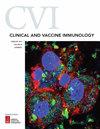Serological Analysis of Tuberculosis in Goats by Use of the Enferplex Caprine TB Multiplex Test
Q2 Biochemistry, Genetics and Molecular Biology
引用次数: 21
Abstract
ABSTRACT Tuberculosis in goats is usually diagnosed clinically, at postmortem, or by a positive skin test. However, none of these approaches detects all infected animals. Serology offers an additional tool to identify infected animals missed by current tests. We describe the use of the Enferplex Caprine TB serology test to aid the management of a large dairy goat herd undergoing a tuberculosis breakdown. Initial skin and serology testing showed that IgG antibodies were present in both serum and milk from 100% of skin test-positive animals and in serum and milk from 77.8 and 95.4% of skin test-negative animals, respectively. A good correlation was observed between serum and milk antibody levels. The herd had been vaccinated against Mycobacterium avium subsp. paratuberculosis, but no direct serological cross-reactions were found. Subsequent skin testing revealed 13.7% positive animals, 64.9% of which were antibody positive, while 42.1% of skin test-negative animals were seropositive. Antibody responses remained high 1 month later (57.1% positive), and the herd was slaughtered. Postmortem analysis of 20 skin test-negative goats revealed visible lesions in 6 animals, all of which had antibodies to six Mycobacterium bovis antigens. The results provide indirect evidence that serology testing with serum or milk could be a useful tool in the diagnosis and management of tuberculosis in goats.应用山羊结核菌复合试验对山羊结核菌进行血清学分析
山羊结核病通常在临床、死后或通过皮肤试验阳性诊断。然而,这些方法都不能检测到所有受感染的动物。血清学提供了一种额外的工具,以确定当前检测遗漏的受感染动物。我们描述了使用Enferplex山羊结核病血清学测试,以帮助管理一个大型奶山羊群经历结核病崩溃。初步皮肤和血清学检测显示,100%的皮肤试验阳性动物的血清和乳汁中均存在IgG抗体,而77.8和95.4%的皮肤试验阴性动物的血清和乳汁中分别存在IgG抗体。血清和乳汁抗体水平之间存在良好的相关性。这群猪已经接种了鸟分枝杆菌亚种疫苗。副结核,但没有发现直接的血清学交叉反应。随后的皮肤试验显示13.7%的动物呈阳性,其中抗体阳性占64.9%,而皮肤试验阴性动物血清阳性占42.1%。1个月后抗体反应仍然很高(57.1%为阳性),屠宰。对20只皮肤试验阴性的山羊进行尸检分析,发现6只山羊有明显病变,所有山羊都有6种牛分枝杆菌抗原的抗体。结果间接证明,用血清或羊奶进行血清学检测可作为诊断和管理山羊结核病的有用工具。
本文章由计算机程序翻译,如有差异,请以英文原文为准。
求助全文
约1分钟内获得全文
求助全文
来源期刊

Clinical and Vaccine Immunology
医学-传染病学
CiteScore
2.88
自引率
0.00%
发文量
0
审稿时长
1.5 months
期刊介绍:
Cessation. First launched as Clinical and Diagnostic Laboratory Immunology (CDLI) in 1994, CVI published articles that enhanced the understanding of the immune response in health and disease and after vaccination by showcasing discoveries in clinical, laboratory, and vaccine immunology. CVI was committed to advancing all aspects of vaccine research and immunization, including discovery of new vaccine antigens and vaccine design, development and evaluation of vaccines in animal models and in humans, characterization of immune responses and mechanisms of vaccine action, controlled challenge studies to assess vaccine efficacy, study of vaccine vectors, adjuvants, and immunomodulators, immune correlates of protection, and clinical trials.
 求助内容:
求助内容: 应助结果提醒方式:
应助结果提醒方式:


